Growing delphinium, or larkspur, is an amazing way to add drama to your garden. If you’re not familiar with their striking towers of flowers, you can find seeds cheaply online or at your local garden centres, and can pick up young plants on a budget to fill borders with tall colour.
In this article we’re going to give you the ultimate guide to growing delphinium in Australia, from sowing seeds, to taking cuttings (they’re an incredibly easy plant to learn cuttings with), and explain the best way to keep them healthy as they mature.
More...
What is a Delphinium?
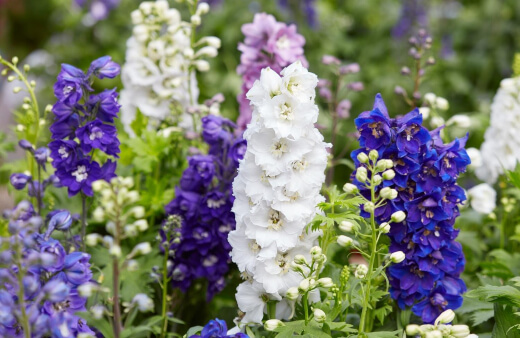
Delphinium, also known as Larkspur, are an herbaceous perennial plant, with dramatic spiked flowers. They are almost all in the blue spectrum, so are a great way to add a bit of hard to find colour to your garden, as one of the only plants with a true blue petal.
As herbaceous perennials they die back in winter after the first frost, and should be cut back in spring if there hasn’t been any frosts over winter to help promote new growth.
While they’re generally easy plants to grow in the garden for high impact, they are short lived, so will need replacing, or diving every few years to reinvigorate them.
What is a Larkspur’s Natural Habitat?
This is a really wide-spread plant through the Northern hemisphere, with around 300 different species of flowering plant.
It’s hard to trace the exact origins of delphiniums, but the tallest varieties of wild larkspur are native to eastern North America in the Appalachian Mountains, and northern Alabama. But there are shorter wild delphiniums that have been found growing in the tropical mountains of Northern Africa.
The common conditions between North America and northern Africa might not seem obvious, but they both share the need for full, uninterrupted sunlight in the summer months, and regular rainfall. They do need good drainage though, to cope with all the water so tend not to grow well in boggy or lowland conditions.
Through cultivation they have been developed to cope with wetter conditions, and some varieties actually prefer high moisture levels, especially in the high summer temperatures of average Australian gardens.
Popular Delphiniums to Grow in Australia
1. Delphinium ‘Faust’
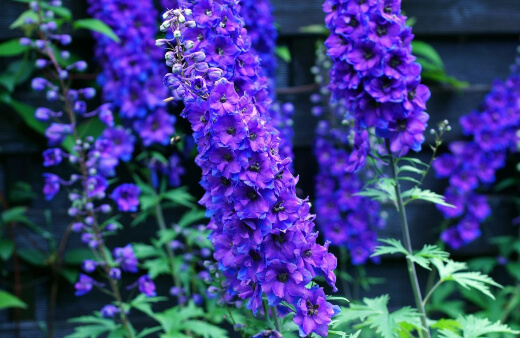
Delphinium ‘Faust’ is one of the few ‘true blue’ flowers you can grow in the garden, with an intense open cyan-blue flower that attracts bees and is perfect for pollinators.
Delphinium ‘Faust’ adores full sun, and good drainage, so is slightly lower maintenance than some other varieties too, making it perfect for warmer parts of the country.
2. Delphinium (Belladonna Group) ‘Atlantis’
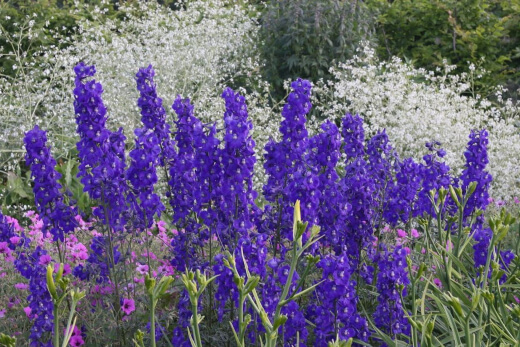
Source: ballyrobertgardens.com
‘Atlantis’ are deep, graded, purple flowers that fade from deep purple to a dark ocean blue in the centre, with white pollen-rich centres that attract all kinds of pollinators with their deep nectar chambers behind the stamen that encourages more wildlife into the garden.
They do require more deadheading than standard larkspur, but belladonna varieties add a unique interest to the garden that you just won’t get in more typical compact spikes.


Get Your Free Guide:
Master Growing Australian Natives eBook
A Must Have Complete Guide for Every Australian Garden
Get Your Free Guide:
Master Growing Australian Natives eBook
A Must Have Complete Guide for Every Australian Garden
3. Delphinium ‘Aurora Lavender’
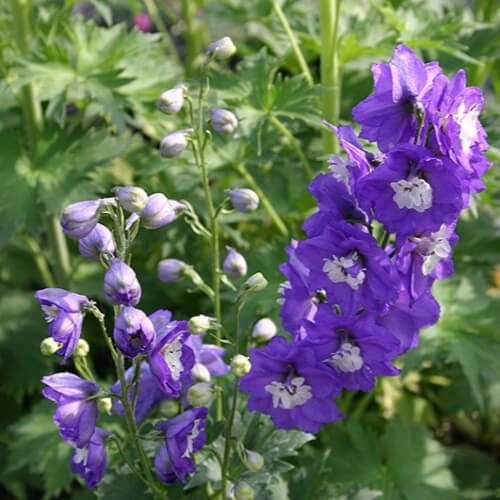
Source: bedsandborders.com
Delphinium ‘Aurora Lavender’ are really wonderful, delicate larkspurs, with tightly compacted flower spikes that reach about 1m tall. They’re shorter than many more popular varieties but that means they fill gaps in the garden that can often be challenging to fill thanks to more limited plant palettes.
Their lavender coloured flowers are a delicate way to fill the mid-level too, without distracting from brighter more impactful plants, and because they’re shorter they tend to need slightly less water in spring while they shoot up their new leaves.
4. Delphinium ‘Highlander Blueberry Pie’

Source: dibora.com.ua
As the name suggests, these are bred from the mountainous delphiniums in more tropical habitats, so are much more adaptable to really well drained, even sandy, solid, and while they still need plenty of water, can recover well from short droughts.
The main reason to grow them though is their magical, almost unbelievably variegated petals, which are blue, white, and violets with some almost pink tones thrown in for good measure. They look like a cake decoration (but don’t try to eat them because they are incredibly poisonous).
The only downside of Delphinium ‘Highlander Blueberry Pie’ is that they’re double flowered delphiniums, which means they are terrible for pollinators, who can’t access their nectar, but as long as you have plenty of other wildlife friendly plants around, it’s nice to indulge yourself an s garden with something purely ornamental once in a while.
5. Delphinium Cherry Blossom
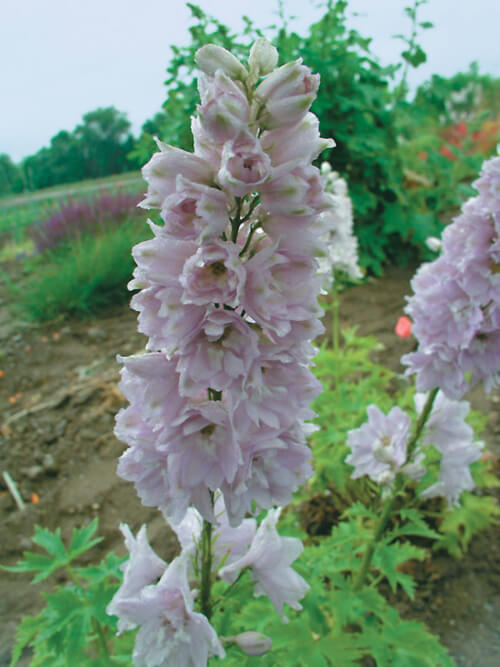
Source: bluestoneperennials.com
Delphinium cherry blossom must have been a serious labour of love for its breeder, with one of the pinkest flowers you can find in any larkspur, which naturally grows blue or purple flowers, and very occasionally pure white.
To find something like this that is so distinctly pink is breath talking, and for any gardeners trying to achieve talk, soft, colour in the garden, this is the perfect plant to add to your border.
How to Grow Larkspur
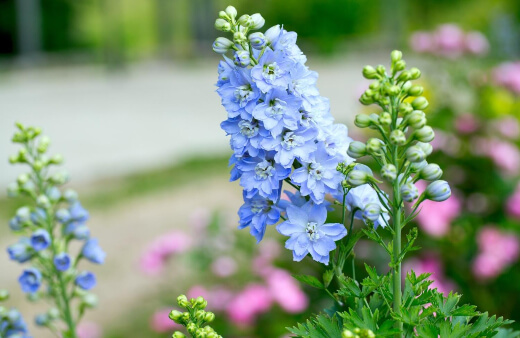
Where to Plant Delphinium
This plant are happiest in the border, surrounded by other ground covering plants to help shade their roots from sun, while allowing their leaves to bask in full photosynthesizing glory.
It’s possible to plant them in pots, but you’ll need to feed and water them much more regularly to achieve the same levels of flower, and the same dramatic heights.
Light Requirements
Delphinium need full-sun, and should always be planted in open spaces where they benefit from as much direct light as possible, but this mean they need a lot of water (almost a gallon per week), so you will need a water-butt to make the most of the rainwater and avoid overusing tap water.
Best Soil for Delphinium
Moist, fertile soil with good drainage is the best soil conditions for them. They don’t like sitting in water or drying out, so finding a balance is important.
If your garden is mostly sandy soil, then boost water-retention by digging compost or manure through the planting hole if your garden soil is heavy clay, then add horticultural grit to the base of the planting hole to improve drainage.
Most importantly though, boost nutrients once a year by mulching over their cut bases in winter, or early spring.
How to Propagate Delphinium
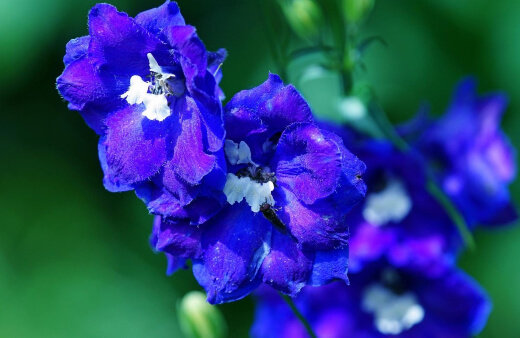
Propagating Delphinium from Seed
Delphinium can be propagated any time in spring, but have a few VERY tricky propagation requirements, so are best planted as early as possible in spring, or even late winter to give you a head start as they can take up to 4 weeks to germinate.
You just need any general seed compost with reasonable drainage to start delphiniums, but prick them out as soon as they reach around 5cm and put them straight into a potting mix with more nutrients to help the young plants develop. The seed compost helps them start out life as gently as possible.
Light Requirements
Delphinium seeds need darkness to germinate, so place newspaper or cardboard over the seeds once you plant them, and check it after 3 weeks. Replace the cardboard and check each day until they germinate, then remove the covering and allow them to grow towards the natural sunlight.
Propagating Delphinium from Cuttings
Taking cuttings is really easy, and produces reliable results, with new plants that are far easier than sowing new seeds. The only method worth trying is basal cuttings, which should be taken in mid-spring when the plants have put on vigorous new growth and are at least 1ft tall.
Simply cut the base of a young shoot that’s shooting from the base of a main stem, trying to include some of the root if possible from just under the surface of the soil. Take one or two shoots from each plant, so the parent plant has enough material to recover from.
Place these cuttings in seed & cutting compost, with added perlite (you can actually take cuttings in pure perlite, but I prefer cutting compost as they can be quite thirsty when they do set root).
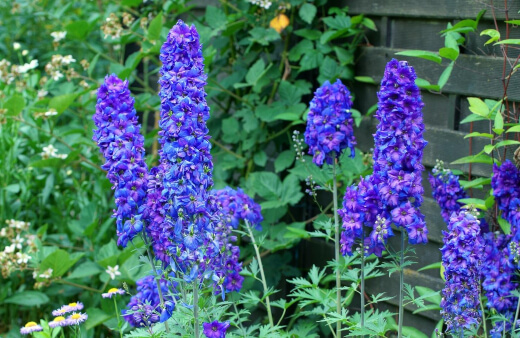
When to Take Cuttings
Take cuttings in mid-spring, once your plants have sprouted and set decent new growth. Remember, you’re looking for the young shoots at the base of the taller stems.
This allows roots to form quickly without needing to strain too hard to take water up long stems to feed existing leaves.
How to Plant Delphinium Cuttings
When cuttings are ready to plant, they’ll have a few new shoots, and should be at least 10cm tall, with roots coming out of the base of their pot. At this point, you can plant them out in the border, or in containers.
Plant them at the same level they are in their cutting pots, and lightly mulch with a rich potting compost or general purpose peat-free compost.
(Peat rich composts, while traditionally used for a rich mulch, can actively damage young plants)
How to Care for Delphinium
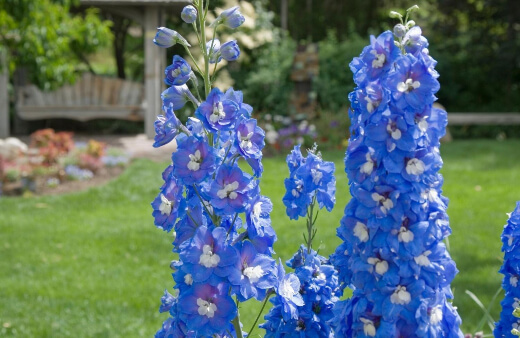
Mulching Larkspur
Delphinium should be mulched when they are planted, whether they’re planted from seeds grown in trays, cuttings, or mature plants from garden centres. Mulching helps them retain moisture, and gives them a nutrient boost.
Mature delphiniums love rotted-0mnanure in late winter or early spring before the new growth starts. This gives them a great boost and should be enough to keep them flowering all summer.
Manure can be too rich for young plants though, so for seeds and cuttings, mulch them with 1-2 inches of general purpose garden compost, or potting compost when you plant them in the ground.
This gives them a gentle boost as they establish roots, without shocking them with overly rich soil. Get to know the types of mulches and which is best for your plants here.
What Fertiliser to Use
Any general garden fertiliser will work but I prefer liquid seaweed or tomato feed which supports flowering and fruits in any plants you feed with it. Read our complete Australian garden fertiliser users guide to learn more.
Obviously the aim with delphinium is regular and prolonged flowering, so by feeding regularly with these high --- feeds, you encourage new flower spikes, and by regularly deadheading spent flowers, and spent flower spikes, new flower spikes will rise up in their place.
Water Requirements
Delphiniums are thirsty plants, but they really don’t like sitting in soggy compost. Ideally, you should water them once a week with a gallon (4L) per mature plant in summer – less if the soil is still moist.
In spring, delphiniums need 3-4L per week to encourage new roots. Healthy roots actively link to healthy new shoots, so watering deeply encourages stronger top growth
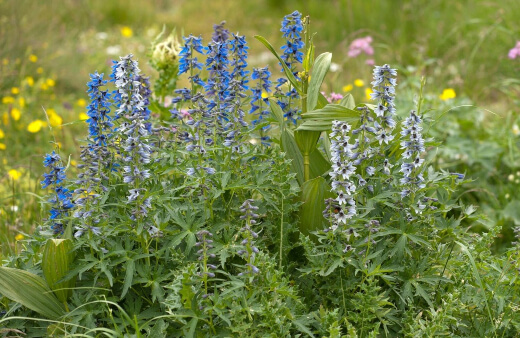
Dead-Heading Delphinium
Delphiniums need deadheading. There’s no question about it. Delphiniums have hundreds of flowers on every spike, and those spikes reach 1m tall.
Each flower spike lasts about 2 weeks before it begins to turn brown and set seed, but every plant is capable of producing 2-3 months’ worth of glorious flowers as long as you remove the spent flowers.
You can remove flowers either one-by-one to maintain the health of the flower spike before a new spike emerges, or remove flower spikes when they are fully spent every couple of weeks.
By removing spent flowers one-by-one, you have a more even display, but it won’t last as long as you’re encouraging further energy in that flower spike, rather than promoting new spikes.
By removing whole spikes when they begin to turn to seed, you stimulate new flower spikes to shoot up as quickly as possible, and the plant knows when it’s lost its flowers and seeds, and its instinct is to draw more pollinators in to start over.
Staking Delphinium
Delphinium are tall plants, with some varieties growing well over a metre tall, so if you live anywhere remotely windy you 100% need to stake your plants.
The traditional method of staking plants is to give them a bamboo cane for every main stem, but because delphinium flower spikes need deadheading, you’ll be tying in new canes every few weeks, and the work just isn’t worth it.
The clever method that commercial growers use is surprisingly useful for the garden though, with discrete bamboo placed in a triangle around the plant.
The bamboo is hidden by the surrounding foliage, and by tying twine between bamboo canes you create a flexible support that allows them to rock in the wind.
By allowing this movement you are creating stronger stems that are more resilient to high winds, and will last longer in storms.
Delphinium Winter Care
Delphinium can either be left in place over winter, or cut back to 15cm above the ground after the first frost. Their stems will turn brown, and as frosts pick up, they will blacken.
It does no harm to the plants’ roots, and many gardeners prefer leaving them in place to add structure to the winter garden. Either way, before the end of winter, it’s best to cut your plants back to just above ground level.
This promotes vigorous fresh growth in spring and new top growth means new root growth too, so it’s helping the overall health of the plant. As herbaceous perennials, delphiniums should be cut back every year before the new growing season even if you don’t suffer from frost in your part of Australia.
Delphinium Pests and Diseases
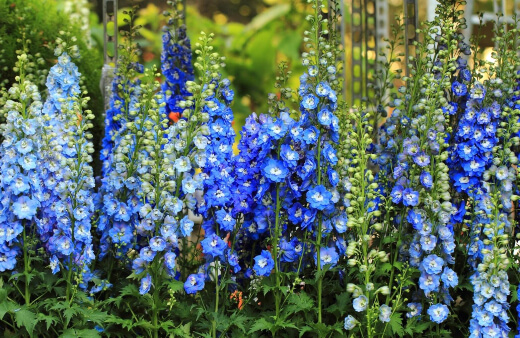
Slugs
Slugs are always a problem, and there’s no real way to get rid of slugs in the garden completely. Slug pellets are ineffective and dangerous (poisonous to you, your pets and your family, as well as slugs), and the old fashioned trick of going outside with a torch will get a handful of slugs, but miss 99% of them.
The good news though, is that they are pretty resistant to slugs once they start growing properly in late spring, so it’s just early-mid-spring that you really need to actively protect them as it’s the young shoots that are most tempting to slugs.
The best way to protect them is to bury a cup or lager in the soil near the young plants. The slugs will be attracted and distracted by the lager, and drown. It’s a bit grim, but it’s safer for other animals than pellets, and is very effective at local plant protection.
Powdery Mildew
Delphiniums are very susceptible to over or under watering, and thanks to their matt leaves can develop miniscule splits in the surface of their leaves when they’re under watered. This damage, along with spider mites that are attracted to the dry plants, cause funguses to get in.
The most common fungal infection in these dry conditions is powdery mildew, which is then worsened if water stays on their leaves as we try to fix it by watering the plant too hastily.
In warm weather, make sure to only ever water at the roots, and try to keep the leaves as dry as possible. This should help prevent mildew from developing.
If you already have mildew, then spray a baking soda solution, or neem oil into the plant. This helps to dry out the fungus, and will hopefully prolong the flowering of the plant and prevent spread to the roots.
Black Blotch
In wet summers, the heat and humidity can create the perfect conditions for black blotch. Delphinium black blotch is a bacterial disease that spreads across the leaves of the plant in summer.
The only way to treat the infection is to remove the leaves and bin them. The best way to prevent black blotch in wet summers is preventative pruning.
Cut out any excess foliage to improve aeration, particularly around the base of the plant, and thin out any overgrown ground cover plants around the base of your delphiniums.
Delphinium Frequently Asked Questions
Do delphiniums come back every year?
Delphinium are completely hardy plants in Australia, and will tolerate our worst winters. The top growth will die back in winter, and if it stays intact, you should prune it back to just above ground level. They will regrow each spring.
When should you plant delphiniums?
Even though they are best planted in spring to boost their natural growth, they can be planted straight into the garden at any time of year. If you plant them in the high heat of summer, they will; usually grow shorter spikes for the first year, but still manage to flower before autumn.
How long do delphiniums last?
Depending on the delphinium variety, the plants will usually flower for 3-4 years if treated well. Make sure to feed them every year, regularly deadhead your plant, and mulch them generously in early spring to give them a boost and take strain off the root system.
It’s possible to get flowers from 5, or even 6, year-old plants, but most delphiniums begin to fade after 3 years.
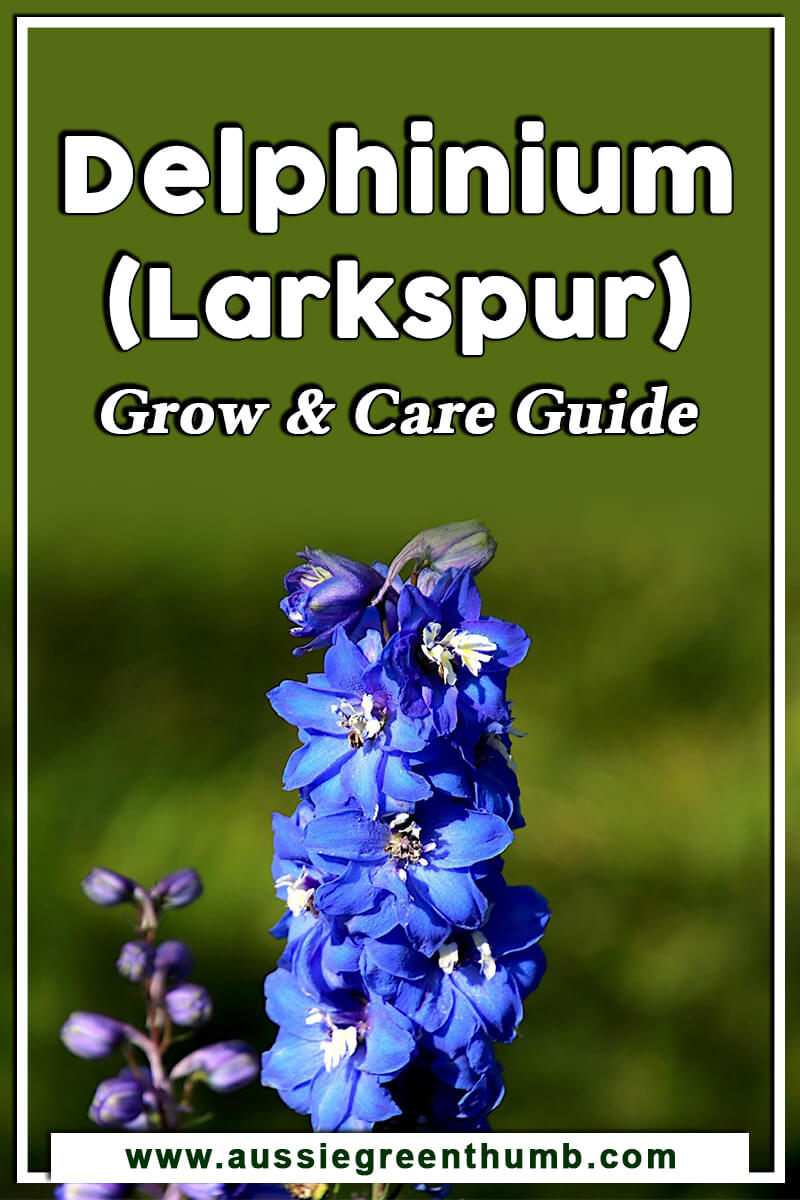
Add a Splash of VibrantColor to Your Garden with Delphiniums
Delphiniums are really striking herbaceous perennials that everyone should grow in their garden. There are plenty of different varieties too, so there’s a delphinium for every gardener, no matter what their style.
I hope our guide to growing delphiniums in Australia helps you get started, whether you’re undertaking the complex task of planting from seed, or just trying to find the best spot in the garden to plant mature delphiniums.
Published on February 24, 2022 by Maisie Blevins
Last Updated on February 12, 2025




